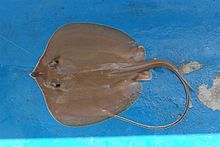Daisy stingray
| Daisy stingray | |
|---|---|

| |
| Scientific classification | |
| Domain: | Eukaryota |
| Kingdom: | Animalia |
| Phylum: | Chordata |
| Class: | Chondrichthyes |
| Subclass: | Elasmobranchii |
| Superorder: | Batoidea |
| Order: | Myliobatiformes |
| Family: | Dasyatidae |
| Genus: | Fontitrygon |
| Species: | F. margarita
|
| Binomial name | |
| Fontitrygon margarita (Günther, 1870)
| |
| Synonyms | |
| |
The daisy stingray, Fontitrygon margarita, is a little-known
habitat degradation, this once-common species is declining and has been assessed as Vulnerable by the International Union for Conservation of Nature
(IUCN).
Taxonomy
British
lectotype for this species. The specific epithet margarita is derived from the Latin for "pearl", referring to the large tubercle on its back.[2]
Distribution and habitat
The known range of the daisy stingray extends from
estuaries; however, this also requires confirmation due to confusion with the pearl stingray.[1]
Description
The
papillae in a transverse row across the floor of the mouth, with the outermost pair set apart from the others. The tooth rows number 24–32 in the upper jaw and 28–36 rows in the lower jaw, and are arranged with a quincunx pattern into pavement-like surfaces. The pelvic fins are short, with the tips projecting just past the disc margin.[2][7]
The tail is longer than the disc and usually bears a single long, thin stinging spine on the upper surface. The tail is broad and flattened at the base, becoming slender and whip-like past the spine with a low dorsal keel and a well-developed ventral fin fold. There is a massive, circular pearl spine at the center of the disc. Young rays are otherwise smooth-skinned, while older rays over 20 cm (7.9 in) across gain a wide band of small, flattened, circular
dermal denticles covering the median third of the back from between the eyes to the base of the tail, as well as small prickles covering the tail behind the sting. This ray is a plain grayish brown above, and whitish below.[2][7] It reaches a maximum known disc width of 1 m (3.3 ft) and weight of 17 kg (37 lb), though most do not exceed a width of 60 cm (24 in).[8] Females grow larger than males.[9] Apart from being much larger, the daisy stingray can also be distinguished from the pearl stingray in having a relatively larger, round pearl spine, fewer tooth rows, and more pectoral fin radials (129–136 versus 113–127).[7]
Biology and ecology
Little is known of the natural history of the daisy stingray.
Human interactions
The tail spine of the daisy stingray is reportedly highly
agricultural runoff and industrial development may also threaten its population. Once common, catches of this slow-reproducing ray have become scarce in recent years, leading the International Union for Conservation of Nature (IUCN) to assess it as Vulnerable. The daisy stingray has not yet been the target of any specific conservation schemes.[1]
References
- ^ . Retrieved 20 November 2021.
- ^ a b c d Compagno, L.J.V. & T.R. Roberts (December 11, 1984). "Marine and freshwater stingrays (Dasyatidae) of West Africa, with description of a new species". Proceedings of the California Academy of Sciences. Series 4. 43 (18): 283–300.
- ^ Catalog of Fishes (Online Version) Archived May 3, 2015, at the Wayback Machine. California Academy of Sciences. Retrieved on January 15, 2010.
- .
- ISBN 92-5-104377-9.
- ^ a b Omotosho, J.S. & M.O. Oyebanji (1996). "Spatial distribution and some body parameters of sting ray, Dasyatis margarita (Gunther) in the inshore waters of Nigeria" (PDF). Nigerian Journal of Pure and Applied Sciences. 11.[permanent dead link]
- ^ ISBN 978-2-7099-1620-2.
- ^ a b Froese, Rainer; Pauly, Daniel (eds.) (2010). "Dasyatis margarita" in FishBase. January 2010 version.
- ^ a b c Omotosho, J.S. and M.O. Oyebanji (1997). On some aspects of the biology of Dasyatis margarita (Gunther) from Nigeria continental shore[permanent dead link]. University of Ilorin. Retrieved on January 15, 2010.
- ISBN 2-88032-949-3.

